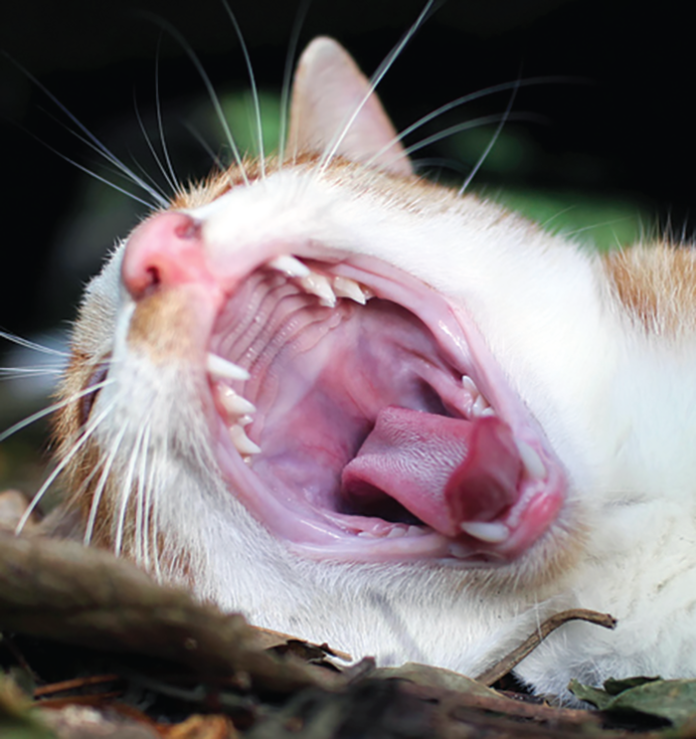A variety of diseases can plague our cats’ mouths, and plague they do: Studies have shown that 50 to 90% of cats over 4 years old suffer from dental disease. Of course, the earlier a problem is detected, the better the prognosis.
Many disorders of the feline mouth are painful. Because cats are so stoic, we may not notice that something is wrong until it has progressed extensively. Regular veterinary exams (once yearly for cats under 10 and twice yearly thereafter) allow you to catch any developing problems in your cat’s oral cavity early.
Gingivitis
Gingivitis is inflammation of the gums. In mild cases, you will notice a thin red line tracing the gums where they meet your cat’s teeth. More severe cases will show more extensive inflammation, and the gums will be prone to bleeding. The damaged gums may recede, exposing the tooth roots.
The good news is that gingivitis is reversible with proper oral hygiene. Dental diets may help to remove the plaque that irritates the gums, but the best way to get your cat back to a clean mouth is to take her in for a full dental examination and to acclimate her to daily tooth brushing with a cat-safe toothpaste.
Periodontitis
Periodontitis is inflammation of the tissues that support the teeth. This condition develops if gingivitis goes untreated. Periodontitis is painful, and as more and more of the periodontal tissues become compromised, the cat’s teeth will loosen and fall out. You will notice swollen, bleeding gums and calculus buildup on the teeth. The teeth may look elongated due to gum recession.
The damage done by periodontitis is often irreversible. A professional dental cleaning removes the harmful bacteria and calculus from your cat’s mouth, allowing the gums to become healthy, but many of the tissues around the teeth (and the teeth themselves) cannot be replaced once lost. Teeth that are broken or damaged should be extracted.
Tooth Resorption
For reasons yet to be discovered, some cats suffer from tooth resorption, where the teeth are gradually broken down. Tooth resorption usually starts at or below the gumline and may affect one or several teeth. Resorptive lesions are painful, and as the tooth is destroyed, it will eventually fall out.
Stomatitis
Stomatitis is inflammation of the mucous membranes in the mouth. The inside of the mouth, including the gums, inside of the cheeks, and back of the throat, will be swollen and red. This condition is extremely painful, to the point where the cat will cry out when her mouth is touched and may clearly want to eat her food but back away from it because she knows eating will hurt.
Extracting all of the premolars and molars often provides relief, suggesting that stomatitis is caused by an inappropriate immune response to something on the teeth (the exact cause is still unknown). In some cats, all of the teeth have to be extracted. Thankfully, cats usually do very well without teeth.
Fibroma
A fibroma is a benign tumor that usually grows along the gumline. They are not generally painful and don’t spread to other areas, but they can grow large enough that they interfere with your cat’s ability to eat normally. Surgery often provides a cure, and you can have the tumor sent out for histopathology to verify that it is non-cancerous.
Malignant Tumors
Squamous cell carcinoma is the most common feline oral cancer, but fibrosarcoma and melanoma are also highly aggressive. These tumors grow rapidly and invade all of the tissues of the mouth. They often have an ulcerated surface and will bleed if disturbed.
Treatment depends upon the exact type of tumor, so it is important to send out a biopsy for a histopathology report. Surgery helps to debulk the tumor and make the cat more comfortable, but in many cases by the time it has been noticed, the cancer has already spread too much to be completely removed. If the tumor cannot be completely removed, radiation therapy may be a useful addition to your cat’s treatment plan.
Xerostomia
Xerostomia, or dry mouth, is when your cat isn’t producing enough saliva. A dry mouth is uncomfortable and makes eating and swallowing more difficult. Xerostomia can be a complication of kidney failure and occurs as a side effect from radiation, certain medications, and sometimes anesthesia. Treatment includes fluid therapy to keep the cat hydrated, moistening the food, and even artificial saliva substitutes.
Being proactive about your cat’s oral care will help prevent the development of some of these conditions. And, as always, if something seems off about how your cat eats or holds her head, or even if she just seems to be hiding more, have her examined by your veterinarian as soon as possible.
What You Can Do
- Check your cat’s mouth once a month or so if she will allow you to
- Get a veterinary exam at least once a year (every six months for cats 10 years of age or older)
- Use plaque-reduction products approved by the Veterinary Oral Health Council
- Introduce tooth brushing as part of your daily routine
- Watch for signs of dental pain, such as changes in eating habits, drooling, pawing at the mouth, head-shyness, and bad breath



